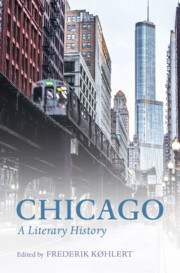Book contents
- Chicago: A Literary History
- Chicago
- Copyright page
- Contents
- Figures
- Contributors
- Acknowledgments
- Introduction: The Literary History of Chicago
- Part I The Rise of Chicago and the Literary West
- Part II Business Unusual: A New Urban American Literature
- Part III Radicalism, Modernism, and the Chicago Renaissance
- Chapter 11 Progressive Chicago: Upton Sinclair, Jane Addams, and Social Reform Literature
- Chapter 12 From the Prairie to the City: Willa Cather’s “City of Feeling”
- Chapter 13 Poetry, the Little Review, and Chicago Modernism
- Chapter 14 A Spirit of Two Ages: The Romantic Modernism of Carl Sandburg’s Chicago Poems
- Chapter 15 Building a Movement: Mary Reynolds Aldis and Little Theatre in Chicago
- Chapter 16 Father to Son: Floyd Dell, Sherwood Anderson, and the Chicago Renaissance
- Part IV A City of Neighborhoods: The Great Depression, Sociology, and the Black Chicago Renaissance
- Part V Traditions and Futures: Contemporary Chicago Literatures
- Selected Bibliography
- Index
Chapter 15 - Building a Movement: Mary Reynolds Aldis and Little Theatre in Chicago
from Part III - Radicalism, Modernism, and the Chicago Renaissance
Published online by Cambridge University Press: 02 September 2021
- Chicago: A Literary History
- Chicago
- Copyright page
- Contents
- Figures
- Contributors
- Acknowledgments
- Introduction: The Literary History of Chicago
- Part I The Rise of Chicago and the Literary West
- Part II Business Unusual: A New Urban American Literature
- Part III Radicalism, Modernism, and the Chicago Renaissance
- Chapter 11 Progressive Chicago: Upton Sinclair, Jane Addams, and Social Reform Literature
- Chapter 12 From the Prairie to the City: Willa Cather’s “City of Feeling”
- Chapter 13 Poetry, the Little Review, and Chicago Modernism
- Chapter 14 A Spirit of Two Ages: The Romantic Modernism of Carl Sandburg’s Chicago Poems
- Chapter 15 Building a Movement: Mary Reynolds Aldis and Little Theatre in Chicago
- Chapter 16 Father to Son: Floyd Dell, Sherwood Anderson, and the Chicago Renaissance
- Part IV A City of Neighborhoods: The Great Depression, Sociology, and the Black Chicago Renaissance
- Part V Traditions and Futures: Contemporary Chicago Literatures
- Selected Bibliography
- Index
Summary
This chapter makes the case that the Little Theatre movement in the United States was a unique outgrowth of the Chicago Renaissance’s diversity, values, and networks. The chapter provides a list of Little Theatre characteristics – including artistic exchange, philanthropy, ensemble theater practice, trends in dramatic literature, and development in theater design – evident in Mary Reynolds Aldis’s work with her Lake Forest Players between 1911 and 1916. By putting the Lake Forest Players in context with Laura Dainty Pelham’s Hull-House Players and Maurice Browne and Ellen Van Volkenburg’s Chicago Little Theatre, the chapter makes clear both how the city’s artistic boom helped create the Little Theatre movement and how the practices that these early Little Theatres in Chicago developed became standard for contemporary non-profit theatre in Chicago and in the United States.
Keywords
- Type
- Chapter
- Information
- ChicagoA Literary History, pp. 208 - 221Publisher: Cambridge University PressPrint publication year: 2021

